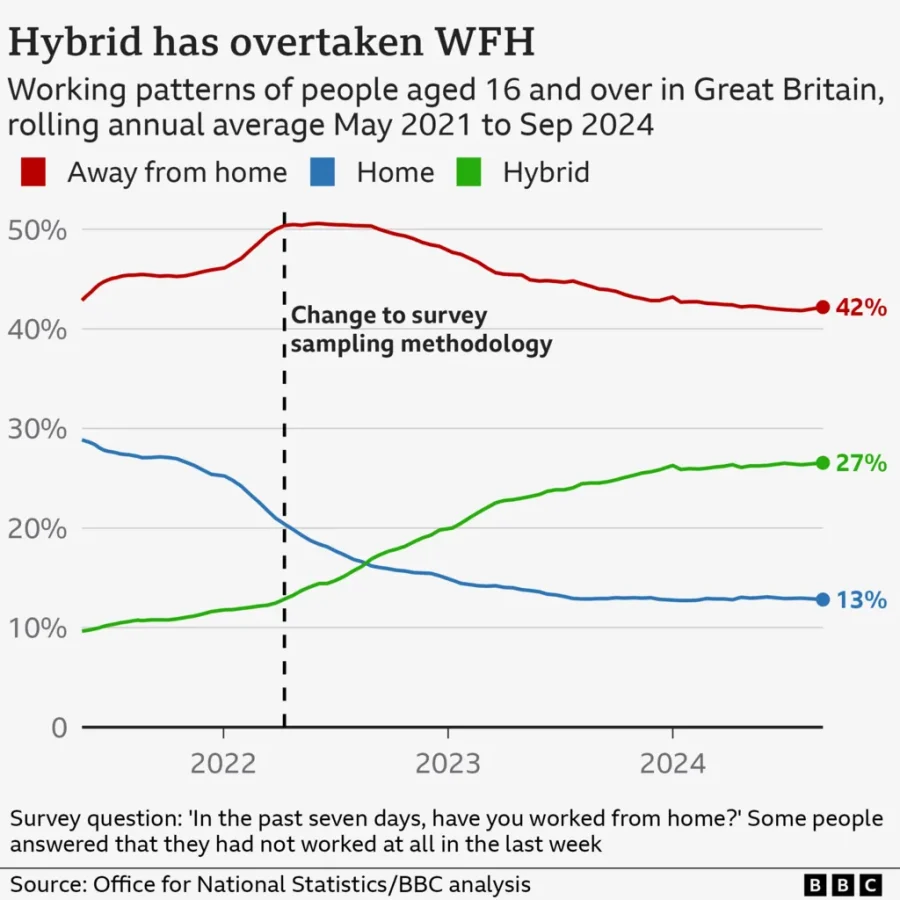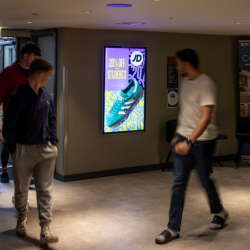Harder, better, faster, stronger. Daft Punk’s 2001 anthem prophesied our technological zeitgeist; two decades on, our lexicon posits a sleek, shiny, yet just as relentless digitised future. Clouds archive our memories, streams curate our entertainment, and intelligence is no longer considered purely carbon-based. Our realities are layered — MR, AR, VR, XR — and through our devices, we can dissolve into code, crossing boundaries to connect with anyone, anywhere. Soon, this metaphor may become reality. With neuromorphic and biotechnologies accelerating, the line between human and machine is set to blur and transhumanism may be closer than we think.
But in our race towards digital transcendence, what is the corporeal cost? As our virtual world expands, our physical spaces contract. Nowhere is this more evident than the evolution of retail. Today, ecommerce titans like Shein, Temu and TikTok Shop dominate the market. On Britain’s high streets — once the pulsing heart of community commerce — 6,945 shops have closed since the start of the year, an average of 38 per day. The erasure of third places has been written about at length; libraries, pubs and clubs evaporating in lieu of streaming and hanging out in the virtual sphere.
This flux in our physical and social landscapes presents both challenges and opportunities. Could this changing paradigm offer businesses a chance to reimagine the role of physical retail? In this article, we’ll explore the multifaceted causes behind these developments and examine how innovative brands are responding — not merely surviving, but redefining purpose around retail and community in the process.
The death knell of UK high streets
The obit for our high streets has been some thirty years in the making. Decades of decline are well documented, from the growth of out-of-town retail parks to supermarkets sweeping small businesses off the board, and more recently: Brexit, the pandemic, changing work practices and skyrocketing inflation, all colliding to sound the death knell for a way of life that is rapidly disappearing. While major cities like London, Birmingham, and Edinburgh will likely recover due to inevitable investor interest, smaller towns, especially those with stark wealth disparities, are haemorrhaging storefronts or stand empty and shuttered.
Research by PwC reveals that an average of 18 chemists, 16 pubs and nine banks shut down every week between January and June 2024. This follows a slew of recent closures from long-standing high street institutions including WH Smiths, New Look, Ted Baker and The Body Shop.
The challenges around retail insolvencies are tenfold. In April, The British Property Federation called for business rates to be capped at 35% of rental levels to help revitalise high streets and town centres. Soaring operational costs further strain the profitability of bricks and mortar; following mounting energy costs in 2022, over half a million UK businesses dissolved.
Whilst the Bank of England’s decision to maintain rates at 5% last week reflects a cautious approach amidst persistent inflationary pressures, retailers continue to grapple with mixed economic signals and uncertainty around consumer spending and growth. For consumers, there’s little incentive to go out and spend. In August, Reuters reported a third consecutive month of plummeting retail sales, with further decline expected in September.
A soggy summer is in some part to blame, and Ipsos polling reveals that a staggering 64% of Brits are savvy to shrinkflation (smaller products, same prices), leading to loss of trust and brand sentiment. And of course, the relentless cost of living crisis has forced many to tighten their purse strings, as 52% of Brits told KPMG they’ve had to cut their non-essential spending.
The internet is often blamed for dying high streets, but its impact requires a nuanced approach. Many of the reasons we once had for visiting in person are now resolved online; either in digital services ( banking, news and music) or products shipped to our doors the next day. Fast fashion juggernauts like ASOS and Shein deliver unmatched choice and convenience, with 24/7 shopping, discounts and low-cost returns, though concerns around product quality and ethical consumption abound.
Some defunct brands live on online, most notably Debenhams via Boohoo’s buyout — but for many, the lost art of live shopping deals a significant blow. In Leicester, one shopper donned funeral attire to mourn the closure of her local Marks & Spencer. When interviewed, she said: ‘I used to come here because I knew people, I felt connected. This is ripping the heart out of Leicester, it’s not just a shop closing, for me it’s a chapter of my life that I will never get back.’ Another branch on Walworth Road, which first opened during the Edwardian era, closed its doors after 111 years in April.
The erosion of our high streets doesn’t merely mean fewer places to shop. They are cultural heritage sites; vital arteries for local economies and identity. We risk losing what makes our neighbourhoods special, and the communal spaces that unite the people who inhabit them.
Third places, and rediscovering local community
The places we’re from shape us. In March, Gemma Jones penned a brilliant article for MediaCat on why brands should think like place-makers. I highly recommend reading the entire piece, but I want to highlight a particular observation: ‘As cultural identities become increasingly shaped by diaspora experiences, culture drawn by national borders over-simplifies and fails to capture the diverse identities and tastes of contemporary audiences. Places and their neighbourhoods have a beautiful way of encompassing different temporalities — heritage coexists with the future and both leave their mark on the present.‘
Neighbourhoods are essential to our social fabric. Third places offer opportunities for strangers to drift into each other’s lives, for debate and diverse perspectives — and in their diminishing presence, we’re more siloed and lonelier than ever. Fifteen years of austerity has resulted in countless casualties. Over two thirds of council-run youth centres are now closed in England and Wales, creating what UNISON calls a ‘lost generation of young people unable to access vital support at a crucial time in their lives.’ Outside of major cities, clubland is in crisis. This month, the BBC reported that over 180 libraries have shut since 2016, resulting in the loss of 2000 jobs and essential free spaces for internet access, learning and gathering.

Less discussed is the dynamic shift of ‘second places’. The pandemic sparked a workplace revolution, prompting many companies to adopt hybrid and remote models. Now, with the labour market stabilising, firms like Amazon, Santander, and PwC are re-evaluating this flexibility — the latter even planning to monitor remote hours. This coincides with UK government support for flexible work and new legislation allowing four-day workweeks as soon as this autumn.
Ironically, coffee shops — the quintessential third place of 17th-century London — are experiencing a renaissance; one in four Brits report working from them weekly, with 34% citing a desire to be around other people.
At our core, we are wired for connection. Recent findings from The National Lottery’s Community Fund emphasise the vital role of community in fostering resilience and wellbeing. Despite mounting pressure on community-run support services such as food banks, debt advice and mental health charities, their research reveals that community connections have strengthened. 74% of respondents said they felt more connected to their neighbours than before the pandemic, reflecting a renewed appreciation for local ties in tough times. 49% conveyed their intentions to volunteer in 2023, with young people (18-24) leading the way (69%).
The regeneration / gentrification tightrope
Urban sociologist Ray Oldenburg, who coined the term ‘third place’, emphasised the critical need for these spaces to be accessible to all: ‘In the absence of informal public life, living becomes more expensive. Where the means and facilities for relaxation and leisure are not publicly shared, they become the objects of private ownership and consumption.’
Modern public spaces increasingly come with a price tag or proof of purchase, whilst parks, once open to everyone, are increasingly reserved for festivals and private events. This shift turns them from inclusive third places into luxury experiences, excluding large swathes of society. Our dying high streets are emblematic of our country’s economic inequality. With some of the ‘deepest spatial inequalities and regional productivity divergence among the OECD countries’, the disparity in R&D investment between London and the South East compared to the rest of the country has profound implications for regeneration efforts in urban centres across the UK.
In traditionally industrial cities like Leeds, Sheffield and Newcastle, areas have been repurposed into cultural spaces and studios, but concerns about the displacement of local residents and independent businesses remain. Manchester’s Northern Quarter, infamous for its record shops and music scene, is now home to hostile architecture and doubled housing figures.
Liverpool’s Baltic Triangle has experienced significant redevelopment, yet many locals worry that new developments cater more to affluent newcomers than to the existing residents, further intensifying concerns about displacement and the loss of local character.
Without equitable investment in regeneration efforts, these cities risk losing their unique character to gentrification, eroding the very fabric of their communities. Addressing this ‘geography of discontent‘ is essential—not just for preserving local identities, but for fostering vibrant retail spaces that can thrive alongside the communities they serve.
Forging retail destinations and communal experiences
What will happen to our high streets? The irony is, we mourn their slow deaths whilst actively driving their decline — each click on an online checkout pushing them further into obsolescence. The solution for businesses is clear: if retail is to survive, it must transmute the transactional. Our high streets can no longer merely be places to shop. For brands that tout purpose, this is the chance to make good on those promises — by reshaping retail spaces into hubs that intentionally prioritise both community and commerce, and extend beyond the scope of cookie-cutter experiences.
Concept stores are at the forefront of the phygital transformation, blending the physical and digital to create innovative shopping experiences. Korean eyewear brand Gentle Monster features giant kinetic head and art installations, using theatrical and unconventional displays to transport visitors to surreal worlds. Nike’s House of Innovation flagships present shoppers with interactive gaming stations, sneaker labs and hyper-personalised recommendations, based on user data from the Nike app.
In April, I briefly stayed at Fabrika — a former factory that now serves as a cultural hotspot for Tbilisi’s creative class, featuring a hostel, film lab, eateries, bars and independent record and clothing stores.
Similarly, the Store X in Berlin’s Soho House merges food, fashion and art to cultivate social interaction. These locales encourage tourists and residents alike to shop, work and mingle, bridging the chasm between commerce and community. Sharing her intent for the store, creator Alex Eagle said: ‘We wanted to create a place where people could spend all day. A light, fresh and fun space where guests can shop, work, eat, drink and hang out. Like an open, shop-able private home for everyone to spend time and where everything is for sale from the candle burning, record playing to the sofa you sit on.’
Other brands excel at understanding their niche audiences, crafting spaces that resonate with their interests and lifestyles: Rapha Clubhouses create sanctuaries for cycling enthusiasts, hosting organised events across their global locations for like-minded customers to connect; and Gymshark’s 55,000-square-foot Lifting Club cost a cool £5 million, and features state-of-the-art gym equipment, an R&D factory, and health bar to support its fitness and wellness community.
Before its closure in 2022, House of Vans was an integral hub for London’s skateboarding scene, boasting the city’s largest indoor skatepark, free art studios for local creators, and a music venue alongside a café and cinema.
To regenerate our high streets with community at the forefront, local partnerships and grassroots initiatives are pivotal. Projects that encourage resident dialogue have already shown how addressing local needs can spark innovative solutions, like Kilburn’s ‘toilet hackathon’ and Milton Keynes’ repair café. In their manifesto, Just Space emphasises that town centres and high streets are ‘local centres of production, identity, and care, not just global exchange and consumption.’ They advocate for community-led audits to amplify local voices, ensuring that the revitalisation of these spaces is not a top-down mandate, but a shared endeavour.
Featured image: Hulki Okan Tabak / Unsplash






























